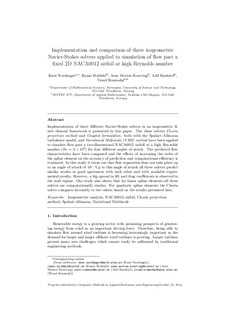Implementation and comparison of three isogeometric Navier–Stokes solvers applied to simulation of flow past a fixed 2D NACA0012 airfoil at high Reynolds number
Journal article, Peer reviewed
Accepted version
Permanent lenke
http://hdl.handle.net/11250/2478994Utgivelsesdato
2015Metadata
Vis full innførselSamlinger
- Publikasjoner fra CRIStin - SINTEF AS [5802]
- SINTEF Digital [2501]
Originalversjon
Computer Methods in Applied Mechanics and Engineering. 2015, 284 664-688. 10.1016/j.cma.2014.10.033Sammendrag
Implementation of three different Navier–Stokes solvers in an isogeometric finite element framework is presented in this paper. The three solvers Chorin projection method and Coupled formulation , both with the Spalart–Allmaras turbulence model, and Variational Multiscale (VMS) method have been applied to simulate flow past a two-dimensional NACA0012 airfoil at a high Reynolds number (Re=3×106Re=3×106) for four different angles of attack. The predicted flow characteristics have been compared and the effects of increasing the order of the spline element on the accuracy of prediction and computational efficiency are evaluated. In this study it turns out that flow separation does not take place up to an angle of attack of 16°. Up to this angle of attack all three solvers predict similar results in good agreement with each other and with available experimental results. However, a big spread in lift and drag coefficients is observed in the stall regime. Our study also shows that for linear spline elements all three solvers are computationally similar. For quadratic spline elements the Chorin solver compares favorably to the others based on the results presented here.
